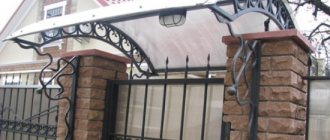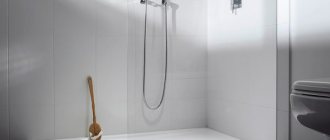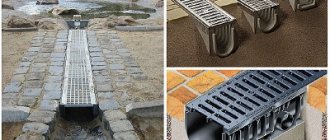Private houses are equipped with a subfloor or basement for storing crops and preserving them. The entrance to the storage facility is equipped with a door or door. If the cellar is under the floor, make a hidden hatch into the basement with your own hands.
Work on equipping Lyada includes several stages: drawing development, material procurement, construction
Hatch designs and what to consider when making them
To ensure that the work on installing the hatch is successful and the result does not spoil the interior of the house, all the details are thought through. Lyada should fit harmoniously into the space of the room. Hatch includes:
- box;
- door;
- awnings;
- handle;
- lock.
The box is placed on the interfloor ceiling in the floor. A wooden hatch is made from a board 15 cm wide and 5 cm thick. A metal box is constructed from a 5*6 cm corner.
A door in a wooden structure is made from a board 2-3 cm thick. If you plan to step on the hatch and it is located in a passageway, the thickness is increased to 4-5 cm. The metal door is made from a steel sheet 3 mm thick. The hatch around the perimeter is reinforced with corners 4 cm wide.
Canopies are chosen from durable material so that they can withstand the weight of the hatch. Handles are made both protruding and hidden, depending on the design and preferences of the owner. Protruding handles from windows and entrance doors are suitable. Rings are used as secret ones. The lock is made from bolts or mortise models.
Requirements for cellar hatches
The basement is used as a utility room. It can store not only vegetables, fruits and canned goods, but also seasonal yard items: a hose, a pool, chairs. The storage facility installed in the house allows the floor on the ground floor to remain warm. When designing, the following requirements are taken into account:
- the location must be on a free site;
- the dimensions of the hatch are chosen taking into account the dimensions of the cellar, at least 75 * 75 cm;
- the door is equipped with a simple handle and lock so that there are no problems when opening;
- if the hatch weighs more than 10 kg, install an electric drive;
- the joints are made airtight so that cold air from the underground does not enter the rooms;
- the box is equipped with reliable supports;
- the hatch under the laminate is made of boards;
- To prevent the door from closing while the owner goes down to the cellar, it is equipped with a gas shock absorber.
The location for the hatch is chosen to be impenetrable so that when opening the door it does not touch the furniture. Types of hatches for cellars and basements
Modern manufacturers offer a wide selection of hatch models by type and size. There are different designs:
- swing doors - consist of one or two doors, each is attached to 2-4 hinges, a handle is installed on one side, and a latch on the other;
A hinged hatch is installed in a large cellar with a comfortable wide staircase - removable - the door is a separate element with a handle, it is installed on the opening in the frame;
If a hidden structure is intended, a ring is attached instead of a door handle - sliding – the door along guides in the frame opens a passage to the underground;
The box for the sliding hatch is made of reinforced metal corner - concrete - for such a design a frame is built from a metal profile, made for street or garage cellars;
To install a concrete door, the frame is reinforced with reinforcement, after which the frame is filled with cement mortar
Attention! To prevent the structure from collapsing into the underground floor under the weight of the door, the frame is made of a steel profile. Massive metal loops are used as fastenings.
Types of hinges and handles for cellars
Hinges for a self-made cellar lid are selected based on the weight of the door structure. The heavier the entrance, the more reliable the fasteners should be. For hidden models, secret loops are selected. Fasteners are divided into groups:
- overhead, similar to door hinges, but have the disadvantage of visible gaps;
- hidden, installed from inside the hatch, such fasteners open the structure by 900;
- hinge-brackets are attached to secret lids, the model looks like a question mark;
- The pantograph resembles a scissor hinge; the door first rises up and then swings back.
The requirements for a hatch handle are not the same as for entrance doors. The lyada handle can be nondescript. Its purpose is to be invisible, not to protrude high, so that the residents of the house do not get injured by it. More often, secret models are installed for the cellar hatch or rings and hinges.
If small children live in the house, install a removable handle
Drawings with cellar hatch dimensions
Any construction work is carried out according to sketches and dimensions. When designing, take into account:
- floor horizon;
- landing size;
- frame perimeter;
- hinge fastening is added to the width of the opening so that the hatch can open;
- height includes the thickness of the material and the insulating layer;
- convenient opening;
- fastening gas shock absorbers;
- angle and clearances required to open the door.
The dimensions of the ice are determined based on the area of the cellar. Do-it-yourself cellar lid drawings are shown in the photo below:
Before drawing the drawing, determine the location for the hatch
The open lid should not touch interior items. The minimum dimensions for a hatch are 75*75 cm. The method of arranging the box depends on the choice of material. There are lightweight and reinforced designs. When arranging tightness and thermal insulation, additional dimensions are taken into account and applied to the drawing.
The sketch should reflect the method of opening the hatch
To prevent the lid from falling and hitting the owner on the head during descent and ascent, a soft closing system and a latch are installed. A lock or removable handle is installed in homes with children and animals.
The electric drive is capable of turning the cellar into a reliable, inaccessible storage facility and tightly closing the doors if necessary.
The drawing shows the method of attaching the box to the interceiling. If necessary, it is reinforced with metal corners 5*6 cm, which are mounted in the floor rafter system.
If the door is made of steel sheet, the frame is made of a metal profile reinforced with corners
Types of loops
During installation the following are used:
1. Stretched overhead hinges, fixed on one side of the hatch and on the floor or wall. The cost depends on reliability and decorativeness; maximum costs are observed when using forged types.
2. Hidden, mounted in the ceiling or internal frame and allowing the basement door to be brought to the same level as the floor covering. When choosing this option, the hole in the underground is easily covered with a carpet; only the owners of the house will know about it.
3. Driven mechanisms that automatically open and close heavy and massive hatches, most often metal. This variety, in turn, is divided into retractable and folding groups.
4. Pantographs that ensure sequential movement of hatches upward and only then to the side. When using such hinges, the edges of the door come out of the ceilings without problems, regardless of the thickness of the materials. The best results are achieved when they are installed on wooden structures and doors with two leaves.
5. Gas shock absorbers, closers and stops, simplifying the lifting of the hatch from the cellar and allowing it to be fixed in the desired position. The main advantage is the ability to lift heavy doors made of metal and wood by one person when they are positioned horizontally.
Regardless of the type, the fasteners used are subject to strict requirements in terms of withstanding weight loads, ensuring backlash and anti-corrosion protection. Hinges, like handles, are purchased with a reserve. For small manhole sizes (within 0.75-1 m2), two pieces installed closer to the corner are sufficient; in other cases, the axis is strengthened in the center. Actively used hatches require metal edging around the edges; this requirement is taken into account when selecting the backlash.
Description of the “Cellar” set
If you make and install it yourself, it’s worth buying a universal kit. Standard kit includes:
- Gas shock absorbers (stops) with the required length and force (from 500 N and above).
- Mounting brackets, including wall bracket.
- Hidden hinges (left and right) with a bracket for a gas shock absorber and central ones without it.
- A prefabricated lock consisting of a mounting and lifting plate, a locking part with a set of keys that simplify opening the hatch and lifting it.
The Cellar set can be purchased fully equipped, but in most cases not all of its parts are used. When installing a simple basement hatch without shock absorbers, the central hinges and lock are sufficient. Regardless of the selected configuration, the mount ensures free opening of the hole with a minimum gap along its perimeter with a floor covering thickness of up to 1.5 cm. Hidden or secret handles with brackets or a ring are purchased separately. The cost of the parts included in the Cellar kit varies from 150 to 1500 rubles; they are characterized by high quality metal and anti-corrosion protection.
What tools and materials will be needed
The choice of material depends on what the house and floor are built from. In wooden log houses, boards are used. In concrete floors, combined structures are used: a metal frame, a wooden door. The finished hatch is easy to install; making it yourself according to the drawings is not difficult.
The cellar located in the house is most often equipped with a wooden hatch. There are no requirements for this design. If the arrangement of the entrance to the basement is possible only in a passage area, it is made of metal.
To implement the project you will need the following tools:
- Bulgarian;
- drill;
- screwdriver;
- welding machine;
- roulette;
- level;
- handle;
- loops;
- gas shock absorber;
- latch;
- selected material.
For wooden boxes, timber 5 cm thick and 15 cm wide is used. For doors, boards 2-3 cm thick and 10-15 cm wide are used.
For metal structures, a profile of 3*4 cm and a corner of 5*6 cm are used for the frame. The box is welded from a steel corner.
Determining the size of the hatch
There are no standard sizes for a basement opening. Designs are divided into two categories: with straight and oblique stairs.
The passage from the hatch to the basement floor is 1.5-4 m, so the cellar is equipped with a ladder
For vertical structures, the entrance is built small, the width of the stairs. The largest family member with a full bag should fit into the opening. For inclined structures, the entrance is made larger. The length of the hatch can reach 2 m. If the ladder is installed at an angle of 450, it makes no sense to increase the length, since the head does not reach the ceiling.
Installation nuances
When choosing hinges for a cellar hatch, experts advise paying attention to the subtleties that determine the reliability of the product. It is worth checking the following parameters:
- Correspondence between hatch sizes and fittings. For a large and heavy lid, two hinges may not be enough.
- Door quality. Even light structures made of plywood or chipboard need to be reinforced with a metal corner. There is a significant load on the edges, and the strength of the wooden material may not be enough.
Original transparent hatch with hidden hinges Source birzhaplus.ru
- Quality of connections. You should not skimp on hinges, because they bear the entire weight of the structure during its movement. If you give in to the temptation to save money, you will become the owner of fittings that will only support a small plywood door, but not a high-quality steel or oak hatch.
- Precise fit. Careless assembly will sooner or later lead to jamming. To avoid an unpleasant situation, it is necessary to leave a small gap between the moving parts.
- Possibility of service. It is necessary to maintain access to the mechanism for periodic inspection and maintenance (lubrication or repair). Rotating parts are lubricated with oil (or lithol) once a year; if the basement is actively used, then more often. Both hinged and hidden hinges need processing.
Automatic gas lift hatch Source remkasam.ru
How to make a wooden cellar hatch cover at home with your own hands
To make a cellar hatch out of wood with your own hands, prepare the material. Beam 5*15 cm for the box and board 3*10 cm for the door.
Stages of work:
- Parts are cut from the timber according to the drawings. A milling cutter is used to remove the rebate to hold the door with a depth corresponding to the dimensions of the project. The size of the opening is 1 cm larger than the box. For mortise hinges, a recess is made to the thickness of the parts.
- Using a square, draw a perpendicular line at the ends. The boards are cut along the marked lines. Trimming is performed with a circular saw.
- The box is assembled with 10-12 cm nails. Using the square, the base is inserted into the opening.
- The length of the door boards is made 2 mm shorter so that it can move freely.
- The door is assembled on the guides. Screw the hinges and install them in the opening.
- Check the functionality of all elements.
If the hatch and door do not correspond to the opening, check each part with a square, because during assembly the structure was skewed.
Attention! Before carrying out work, all wooden elements are coated with drying oil or a moisture-resistant agent so that the hatch does not rot from the dampness of the basement.
LOOP KINEMATICS
Thanks to the installed spring in the hinge mechanism, it opens automatically, i.e. To fold the hinge (close the door), you must apply external force (for example, using your hand) and hold it (for example, using a mini-latch). When the external force holding the loop in the folded (closed) position is neutralized, the loop automatically unfolds (opens) under the action of a spring. Thanks to the system of levers and axes of rotation, the hinge has a fully specified (defined) elliptical trajectory with a shiftable center of rotation, which ensures easy opening and closing of the door with one hand, and the thickness of the door (with glue and tiles) can reach up to 28 mm or more (in this case, the opening angle will decrease depending on the thickness of the door with adhesive and tiles). Using these hinges, you can make a tile hatch with your own hands. 100% localized in RUSSIA: from the metal to the spring and hinge assembly - made in the Russian Federation.
How to make a metal hatch into a cellar yourself
To make a lyada from metal, prepare a metal profile 4*5 cm, a corner 5*6 cm to strengthen the structure, and a sheet of steel 3 mm thick.
Step-by-step instructions for creating a basement hatch with your own hands:
- Parts from the profile are cut according to the dimensions indicated in the drawings. It must be at an angle of 450, it’s more convenient to cook and mount. Using a square, the parts are aligned and connected by welding.
- The workpiece is placed in the opening. If the sizes do not match, they are adjusted.
- A rectangle is cut out of a sheet of steel to fit the size of the door. Its parameters are 5 mm smaller than the inside of the box.
- Check the size of the door and apply the workpiece to the box. Parts are cut out from the corner and welded to a sheet of steel. The structure is reinforced not only around the perimeter, but also inside it. This creates an internal sheathing.
Weld the hinges to the door and frame, check the operation of the hatch - To attach the hatch to the opening, holes are drilled in the box and secured into the ceiling with anchor bolts.
The outside of the lid is painted or lined with decorative material, and the handle is screwed on
A sealed hatch into the cellar with your own hands allows you to rid the room of the cold and cuts off the penetration of hot air into the cellar. Reliable insulation keeps unpleasant odors out of the basement. Felt tape or door seals are used to seal joints.
Preliminary actions
Before manufacturing and installing the hatch cover, you must perform the following steps:
- It is necessary to secure metal corners or wooden blocks along the edges of the hatch. They will serve as lid latches and will prevent it from falling down.
- It is advisable to make a metal grate made from pieces of reinforcement. It is needed so that insulation can be placed on it in winter. The grille can be mounted on hinges or made in the form of a removable structure.
- The perimeter of the hatch should be lined with strips of door seal or felt. This will help create a more airtight structure.
Making a plug
After the preliminary work has been completed, you can begin making the plug. To do this, you need to adhere to the following algorithm of actions:
- From the material chosen as the basis for the hatch, we make two identical square-shaped sheets, the size of which will correspond to the future cover.
- Next, we make the door frame, which, to give greater strength, must be reinforced with transverse inserts.
- If wood is chosen as the material, the surface of the parts must be impregnated with antiseptic substances. This is done so that the increased humidity inside the cellar does not spoil the hatch and leak into the room.
- We attach one of the sheets to the frame from below, eliminating all the roughness of the structure.
- We fill the empty cells with insulation, making the layer as dense as possible.
- We install the second sheet on top of the finished structure and securely fasten them.
Remember: the plug must be durable and withstand a lot of pressure. Otherwise, it may become deformed and break, resulting in injury or injury.
Installing hinges
Selecting hinges for the cellar lid:
- Overhead loops. The cheapest and easiest option.
- Hidden loops. Due to their design, they are mounted directly inside the hatch or in the ceiling. Their use allows you to install the door in the same plane with the floor, making it invisible to strangers.
- Pantographs.
- Hinges equipped with a drive that allows you to open and close the hatch automatically. They are used in cases where the hatch covers are too heavy and it is difficult for a person to open them on their own.
- Closers.
If the hatch cover is small, two hinges are installed on it, which are located closer to the corners of the structure. Large hatches are reinforced with a third hinge, which is attached in the middle.
The standard kit that you need to purchase to fully fix the cover will look like this:
- A set of hidden hinges (right and left), which are equipped with special brackets for attachment to the shock absorber.
- Shock absorbers of the required size.
- Fasteners.
- Hatch lock.
You can purchase a lifting mechanism for basement hatch covers in the store
This set of parts can be purchased in one set at once in specialized stores.
Installation of handle and sealing
The handle for the cellar lid plays an important role, and when purchasing it, the following nuances must be taken into account:
- You cannot install a regular door handle on the hatch. The fact is that it will protrude above the floor surface and can be easily caught on when walking. This is against safety regulations and will result in hazardous situations.
- For our purposes, hidden cellar handles made of galvanized steel are perfect.
- For removable hatches it is necessary to make two handles on the sides. This will make it easy to lift the cover and replace it if necessary.
After installing the handles, you need to take care of sealing the hatch. This is necessary so that odors and dampness do not penetrate into the main room. The standard sealing option is to use door seal or felt. Strips made from this material are attached along the contour of the hatch and ensure not only the tightness of the room, but also muffle the sound of the lid closing. If the entrance to the cellar is located on the street, the door must be lined with polypropylene.
How to make a manhole cover with gas shock absorbers for a cellar with your own hands
A gas shock absorber is attached to a previously made wooden, metal or combined hatch to make it convenient to descend and descend into the cellar. The smooth movement of the door and its fixation make the operation of the hatch convenient. Shock absorbers are selected based on the resulting weight of the door. Installation method:
- Open the lid.
- Mark the attachment points on the door and frame.
- Make holes according to the markings.
- If necessary, in the places of fastening to wooden parts, recesses are made according to the size of the fasteners.
- Gas shock absorbers are attached using self-tapping screws.
A hidden handle with a latch will prevent accidents from children falling into the cellar
How to make a power sunroof
To protect households and control the opening of the hatch, a lifting mechanism for the lid into the basement is made. Prepare an electric cable, a drill, an electric drive. Installation is carried out on the hatch cover:
- The lyada door is set to less than 900.
- Weld the fastening loops. Mark the attachment points. Make holes.
- Screw the electric drive mechanism with self-tapping screws.
The entire electronic system is placed under the floor and does not interfere with the opening and closing of the cellar hatch door
Creating a retractable mechanism
If you plan to build an entrance to the cellar in the house, you can equip the door with a retractable mechanism. To fix it, there must be a small space under the floor. To construct such a cover, do the following:
- Buy steel rods. To move the door you will need a set of rollers.
- The lid will open and close by installing 2 electric motors. To operate them, you will need to lay an electrical cable and need a power source.
- Switching on and off is carried out thanks to a switch that has 3 positions.
Electric inspection hatch: installation features
To make lifting the heavy hatch door easier and protecting the basement from thieves, the hatch can be equipped with an automatic system. The easiest way is to build a folding mechanism. To make it you need to prepare:
- electric motor;
- duralumin pipe;
- steel sheet;
- steel rods;
- Bulgarian;
- welding machine;
- toggle switch (switch) 3 positions;
- presence of a current source.
The mechanism is mounted on a ready-made hinged lid; the opening angle of the hatch will be less than 90°. The principle of operation is as follows: the electric motor receives a signal from the remote control, driving the shaft. The rod rises 80° and the device fixes the hatch in the open position. The second toggle switch gives an impulse through the control panel and starts reverse thrust on the motor. The rod lowers and pulls the door behind it.
A hidden hatch is a practical option for arranging a basement entrance. The lid and lifting mechanism must be safe and easy to use. You can create a hatch yourself, without the use of expensive equipment or the help of professionals.
How to properly make a basement hatch cover under tiles with your own hands
The cover for the basement under the tiles is made with your own hands according to a pre-drawn sketch. All work is carried out in three stages: floor screed, hatch installation, tiling.
Operating instructions:
- Determine the thickness of the tiles and the level of coverage. The opening for the cellar is beaded around the perimeter. In the room they make a screed under the tiles.
Leave 5-10 cm as support under the hatch cover - Tiles are laid on the floor in the room. At this stage, one row around the perimeter is left without tiles.
- Install the hatch frame, leveling it. The gaps between the screed and the frame are sealed with concrete. Lay out the last row of tiles, cutting them to size.
The opening is lined with plaster - Reinforcement is attached to a steel frame and filled with concrete. After drying, glue the tiles on top, matching them to the pattern on the floor. The seams must match.
The final touch is grouting the seams and attaching the handles
PURPOSE
What types of cabinet hinges are there?
Transformer hinge PTdSL.139-79-52-190.Нж was specially designed for secret doors, for flush installation of thick doors up to 40 mm, hidden access hatches, invisible hatches, tile hatches
The hinge can be installed in floor hatches and ceiling hatches. ATTENTION! The maximum thickness of the door with trim should not exceed 40 mm. The maximum protrusion of the door, from the hinge side, beyond the edge of the hinge with which it is attached to the opening is no more than 25 mm
If the door thickness exceeds 40 mm, it is necessary to provide landing areas (samples) for hinges on the inside of the door, thinning the door at the points where the hinges are attached to the door.
How to make a hidden hatch cover in the basement under laminate or linoleum with your own hands
A do-it-yourself floor hatch for a basement under laminate, linoleum or carpet is a practical arrangement option. Lyada is made from boards and timber.
Installation steps:
- Make a hole in the ceiling in the selected area. Install the frame. Carpet, laminate or linoleum are laid close to the wooden frame
- Hinges are attached to the door and the part is screwed to the frame.
The outer surface of the door is covered with a selected decorative material, for example, laminate - Seal the cracks, install a gas shock absorber, a clamp and attach the handle.
The inside of the wooden surface is coated with moisture-resistant varnish or paint
How to make a lid for a cellar on the street with your own hands
A do-it-yourself hatch for an outdoor cellar is made from a reinforced metal corner 5 mm thick, 5 cm wide and a steel sheet 3-5 mm thick.
Stages of work:
- A box from a metal corner is mounted on the prepared area.
- A rectangle is cut out of a sheet of steel according to the dimensions in the drawing.
- A corner is welded along the perimeter of the sheet to strengthen the frame, and sheathing is made inside.
- Attach the door to the frame.
- Concrete is applied to the surface of the steel sheet, and tiles or other facing material are laid on it.
- If necessary, attach a handle.
- On the inside, sheets of polystyrene foam, expanded polystyrene or other insulation are glued between the sheathing.
Mineral wool 5-10 cm thick and moisture-resistant gypsum fiber will reliably protect the basement from frost.
Attention! Concrete doors are very heavy. It will be difficult for one person to open them. To facilitate this process, an electric lifting system is installed.
.
Expert advice
According to the developers of cellar mechanisms with hidden fittings, there is no universal calculation method. When selecting, you should take into account the material of the lid, the length of the sash, the width of the shoulder, and the weight of the facing material with glue. Gas lifts are selected according to the location on the finished lid. Measure the force in kg using a cantor (pressure gauge). to lift the finished sash, convert to Newtons (*10), add 30% to the resulting value and determine the total power of the pushers. Next, purchase 2 sets of car stops of different power within the specified values from the store and test them on the model.
Comments from the technical director of the hatch manufacturing plant
“If there are small square lids with 2 gases, they are balanced, that is, the force is proportional to the area.
We increase the area - the effort in the mountain increases (on the open lid). You can’t increase the leverage indefinitely - the gases are linear, which means the force is the same throughout the entire stroke.”
And the casket simply opened: the designers implemented the “grasshopper” idea, which essentially lay on the surface.
Read on... “When increasing the power of the stop, remember the properties of the loop in the form of a bent palm. Look for balance, otherwise the bottleneck will make itself felt: either the rod will bend in an arc, or the loop will be deformed. Therefore, we install 3 hinges on 4 lifts to distribute the load of the stops on each axis of the chassis. Weld a loop assembly from rolled steel with increased resistance.”











